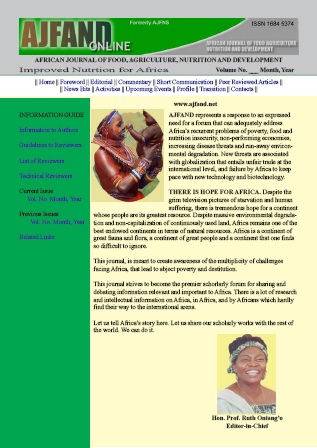
|
African Journal of Food, Agriculture, Nutrition and Development
Rural Outreach Program
ISSN: 1684-5358
EISSN: 1684-5358
Vol. 9, No. 7, 2009, pp. 1524-1547
|
 Bioline Code: nd09081
Bioline Code: nd09081
Full paper language: English
Document type: Research Article
Document available free of charge
|
|
|
African Journal of Food, Agriculture, Nutrition and Development, Vol. 9, No. 7, 2009, pp. 1524-1547
| en |
Studies On The Traditional Methods Of Production Of Maize Tuwo (A Nigerian Non-Fermented Maize Dumpling)
Bolade, MK; Adeyemi, IA & Ogunsua, AO
Abstract
This study was carried out in order to identify the critical areas that could have potential influence on the quality characteristics of maize tuwo (a Nigerian non-fermented maize dumpling) and which might also serve as a basis for any technological improvement effort with respect to the product quality. Commercial producers of maize tuwo were interviewed and their production processes evaluated while samples (maize flour and tuwo) collected from them were respectively analyzed. The investigation revealed that white maize grains of different varieties were commonly being used for tuwo preparation and this has a potential of influencing product quality. The quality factors being used for assessing maize tuwo by the consumers were colour, texture (mouldability and swallowability) and taste. Other critical areas with potential influence on product quality were variation in flour production methods which are grit soaking and grit non-soaking methods and variation in particle size distribution of flour being used in tuwo preparation. Grit non-soaking method was generally being adopted by most maize tuwo producers while the flour from grit soaking method was generally believed to give a better tuwo quality. Variation in the colour indices of maize flour samples was another critical area that could influence product quality. The lightness index (L*-value) of the flour ranged between 88.2 and 88.9 while the chroma (C-value) ranged between 13.3 and 15. There was also a variation in the softness index (textural quality) of maize tuwo. The softness index ranged between 17.8mm and 18.7mm immediately after cooling but ranged between 16.2mm and 17.5mm about nine hours after production. Another critical area that could influence tuwo quality was variation in flour/water ratios involved in product preparation. The ratio ranged between 1:3.3 and 1:3.8. The conclusion made from the ingredient standardization effort was that the overall flour/water ratio for maize tuwo preparation should be 1:3.5. The sequential mixing of flour and water during maize tuwo preparation should also be as follows: initial slurry preparation (20 and 25% of the desired total flour quantity and water volume, respectively), water used in initial boiling (60% of total volume), flour added to the pap-like consistency (80% of total) and water added to the gel- like consistency (15% of total volume).
Keywords
Maize, tuwo, traditional, quality, dumpling
|
| |
© Copyright 2009 African Journal of Food Agriculture, Nutrition and Development.
Alternative site location: http://www.ajfand.net/
|
|
